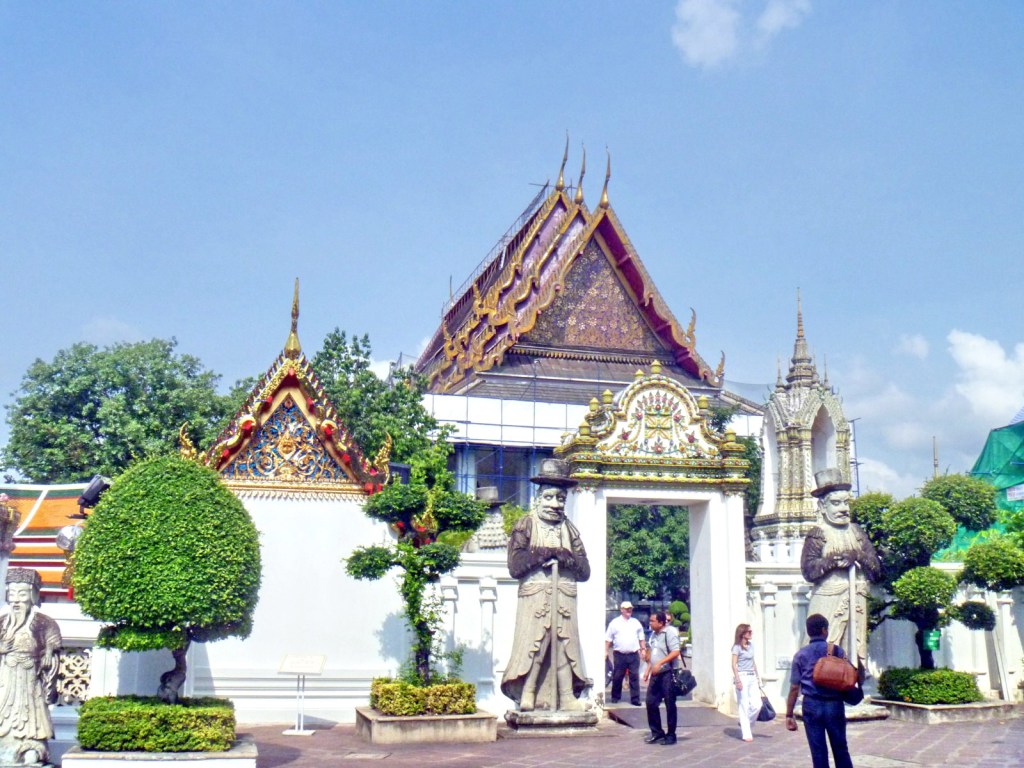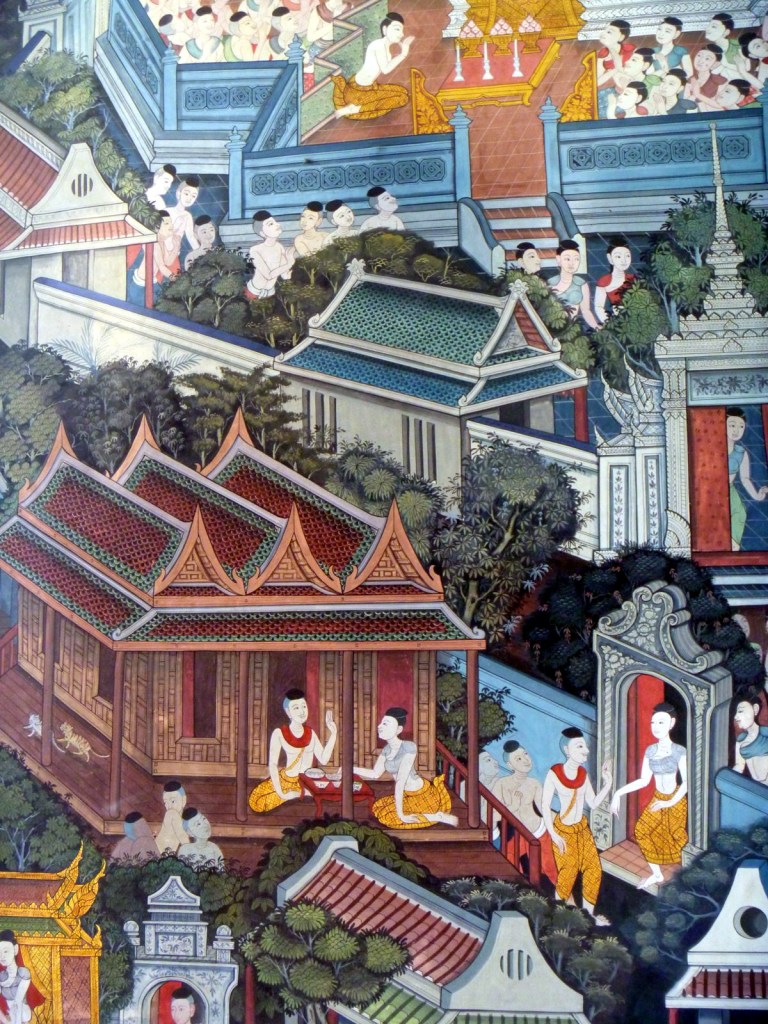After our short visit to Wat Traimit, we all returned to our van and moved on to our next stop, the 80,000-sq. m. (20-acre) Wat Pho (Wat Phra Chetuphon Vimolmangklararm Rajwaramahaviharn), the largest in Bangkok and, technically, the oldest wat, being built around 200 years before Bangkok became Thailand’s capital.
However, the present temple bears virtually no resemblance to its original structure as it was almost entirely rebuilt by King Rama I when the capital was moved to Bangkok. Wat Pho also holds the dual honors of having Thailand’s largest reclining Buddha image and having the most number of Buddha images.
The temple complex, with more than 20 buildings and structures, is walled in on 4 sides with entrances at each side. We entered the complex via the entrance at Chetuphon Road which splits the grounds of the temple into 2, the northern section generally being the only one most people go to.
Standing on both sides of the sheltered entrance gate are the gate guardians lan than nai tvarapala, fierce-face Thai-Chinese style rock giants wearing a tight suit of armor and holding a weapon in one hand. Several Chinese statues also line the outside of temple buildings, a reflection of the Chinese influence during the reign of King Rama III.
After paying the admission fee, we first visited the Vihara of the Reclining Buddha or Phra Buddhasaiyas (Viharn Phranorn). We had to remove our shoes and sandals before doing so. The inner wall of this vihara is decorated of the mural paintings of “Mahawong” (Historical annals of Ceylon) above the windows; and the “13 Savida Atadagga Disciples (Priestess),” “10 Upasaka Atadagga Disciples” and “10 Upasika Atadagga Disciples” between each window.
Inside, we were highly impressed by the gold-plated Reclining Buddha (Phra Buddhasaiyas), made of stuccoed bricks gilded with gold leaves and designed to illustrate the passing of the Buddha into nirvana. Its dimensions were indeed huge, being 46 m. long and 15 m. high. The soles of the 3 m. wide and 5 m. long feet and the eyes are exquisitely engraved with mother-of-pearl decoration of 108 auspicious lakshanas (characteristics) of the true Buddha.
We also visited the Phra Uposatha, the ubosot (main chapel or assembly hall) and the heart of the temple. It was built, in Ayutthaya style, during the reign of King Rama I and reconstructed and enlarged during the reign of King Rama III. All the hardwood windows and doors have crown–like spires and colored glazed tiles. Double marble boundary walls (kampaengkaew), surrounding the main chapel, have 8 sheltered gates and 8 sculpted boundary stones (bai sema). The outer side of the kampaengkaew is decorated with carved stones portraying natural scenes of mountains, trees and animals.
.
Inlays of mother–of–pearl, on the outer side of the entrance door panels, depict episodes from the Ramakien (the Thai version of the world famous Ramayana Indian epic) while, on the inner side, are painted specimens of ecclesiastical fans of rank which are presented to the monk sovereigns.
It is enclosed by 394 bronze Buddha images. Outside the ubosot, there are 152 marble slabs depicting the second half of the epic Ramakian story. Inside is the Phra Buddha Deva Patimakorn, a seated Buddha image on a 3-tiered pedestal called Phra Pang Smadha (Lord Buddha in the posture of concentration). Some of the ashes of King Rama I are kept under the pedestal.
We also took time to explore the large grounds of the temple which contains more than 1000 Buddha images, most taken from the ruins of deserted temples of the former capitals of Ayutthaya and Sukhothai. The Phra Rabiang is a double cloister surrounding the courtyard of the chapel. Connected by 4 main direction viharas, its gallery is lined with hundreds of Buddha images.
The image of Pang Marnvichai (Enlightened Lord Buddha under the Bodhi Tree) and the 10 m. high bronze Buddha image, Pra Buddha Lokanart Satsadajarn, which was brought from Wat Phra Sri Sanpej in Ayutthaya, is in the East Vihara. The inscription of Wat Pho’s establishment is also kept here.
The image of “Lord Buddha Preaching the First Sermon to the Five Disciples” is in the South Vihara, the image of Phra Paleylai in the North Vihara and the image of Pang Nak Prok (Buddha Under the Naga’s Hood) in the West Vihara. The inner side cloister contains 150 Buddha images while another 244 images are located on the outer side, all brought from the northern provinces during the reign of King Rama I. Today, all Buddha images are covered with gold leaves and provided with large glass frames to protect them from birds, bats and dirt. Posted on all columns along the cloister are Thai prosody framed in 100 stone inscriptions by the order of King Rama III.
Nearby is the Phra Mondob (Scripture Hall), built during the reign of King Rama III. It is walled in and has displays of Buddha statues, old ceramics and glassware, tripitaka (teachings of Buddha) and traditional Thai books written on palm leaf manuscripts. It is crowned with a gabled tetrahedron decorated with multicolored Chinese ceramic bowls. There are porticoes at the 3 directions of the Mondob. The library is also impressively decorated with figures and pagodas made of porcelain, in much the same way as Wat Arun, across the Chao Phraya River.
Also near here is the Phra Maha Chedi Si Rajakarn, a group of 4 huge, 42 m. high chedis (round pagodas), constructed to honor the reigns of the first 3 Chakri kings (2 for King Rama III): King Rama I (Phra Maha Chedi Sri Sanpetdayarn, green), King Rama II (Phra Maha Chedi Dilok Dhammakaroknitarn, white), King Rama III (Phra Maha Chedi Muni Batborikharn, yellow) and King Rama IV ( Phra Maha Chedi Song Phra Srisuriyothai, dark blue).
Also around the grounds are 91 massive chedis, of varying sizes, along with chapels, rock gardens, an array of different types of statues, inscriptions, bell towers and resident fortune tellers.
Wat Pho: Chetuphon Rd., Phra Nakhon (Rattanakosin) District, Bangkok, Thailand.Tel: 662-226-0335 and 662-226-0369. Open daily, 8 AM-5 PM.
How to Get There: airconditioned buses 6, 8 and 12 all stop near Wat Pho. The Tha Tien express boat pier is also very near. Ordinary buses 1, 25, 44, 47, 62 and 91 stop along Maharat Rd.; and bus 44, 47 and 91 along Thaiwang Rd. on the north side of Wat Pho, south of Wat Phra Kaew. Wat Pho is also just a short river crossing away from Wat Arun.














